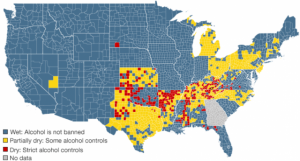- Joined
- Apr 30, 2005
- Messages
- 34,681
200 American counties are still under 1919 prohibition.
It never ceases to amaze me how much people vary.
http://www.bbc.co.uk/news/magazine-17291978
Partial snip:
National prohibition was finally repealed in 1933, but it never quite died out.
When alcohol regulation was handed back to individual states, many local communities voted to keep the restrictions in place, particularly in the southern Bible Belt.
Today there are still more than 200 "dry" counties in the United States, and many more where cities and towns within dry areas have voted to allow alcohol sales, making them "moist" or partially dry.
The result is a patchwork of dry, wet and moist.

It never ceases to amaze me how much people vary.
http://www.bbc.co.uk/news/magazine-17291978
Partial snip:
National prohibition was finally repealed in 1933, but it never quite died out.
When alcohol regulation was handed back to individual states, many local communities voted to keep the restrictions in place, particularly in the southern Bible Belt.
Today there are still more than 200 "dry" counties in the United States, and many more where cities and towns within dry areas have voted to allow alcohol sales, making them "moist" or partially dry.
The result is a patchwork of dry, wet and moist.








300x240.png)